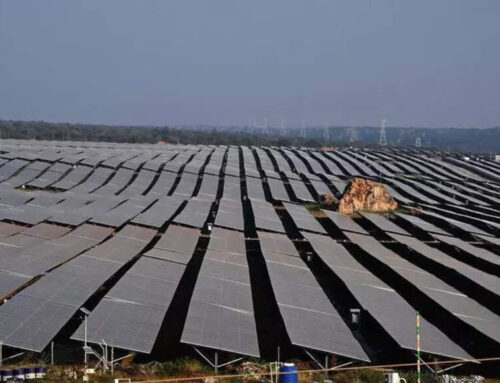Progress Report: Bolder Action Needed To Protect Hawaiʻi’s Environment
May 5, 2025
At Pōkaʻī Bay in Waiʻanae swimmers and paddlers often report coming down with infections and stomach bugs once they leave the water. That includes Carmen Guzman-Simpliciano’s son, who, in 2022, visited the emergency room with an MRSA infection shortly after swimming there.
Six months later, she said, the same thing happened after another dip in the Oʻahu bay. He was 6 years old at the time.
Perhaps that’s not surprising in a spot where water quality testing routinely reveals bacteria levels far higher than what’s deemed healthy. Guzman-Simpliciano, a community advocate who now helps with that testing, says the main suspect for what’s causing all the swim illnesses are cesspools near the stream that empties into Pōkaʻī Bay.
Nonetheless, Legislators took the same approach this year to Hawaiʻi’s cesspool woes as they did to several of the other daunting environmental problems facing the nation’s lone island state: they mostly just chipped away at them.

Specifically, they decided not to budget $5 million to extend a popular grant program that helps low- and moderate-income households get rid of cesspools. Instead, they settled on a pilot program with the University of Hawaiʻi to study new wastewater system technologies.
That three-year study could eventually help scores of Hawaiʻi residents replace their cesspools with lower-cost alternatives, experts say, but it doesn’t address the need to do something about them in the short-term.
Some 11,000 cesspools dot the Waiʻanae landscape, Guzman-Simpliciano said, most of them close to the shoreline. Overall, more than 80,000 such sewage pits leak millions of gallons of raw sewage daily into Hawaiʻi’s beach waters and onto its reefs.
State leaders have set a deadline to remove them all by 2050, but some experts and advocates say that’s too far away and more urgent action is needed to protect Hawaiʻi’s fragile marine environment.
“We didn’t get everything we wanted,” acknowledged Big Island Rep. Nicole Lowen, who chairs the House’s Energy and Environmental Protection Committee and supported extending the cesspool program. “There’s always a lot more work to do.”
However, in regards to the overall Legislative session, she said “this has been a better year than the past couple of years.”
Among the Legislature’s most notable swings this year was the historic new visitor-paid “green fee,” which aims to offset some of the impact tourists have on Hawaiʻi’s environment plus address a host of local climate change concerns.

The stakes for the 2025 session also took on extra challenges for conservation-minded legislators with the election of President Donald Trump, who, unlike in 2016, immediately launched into attacks on the environment, particularly climate change.
Last week, Trump fired all the scientists who work on the National Climate Assessment — a key report that gauges progress addressing climate change — right as the Legislature was winding down. The President is also aggressively working to kill state-led climate initiatives, such as Hawaiʻi’s ambitious goal to run entirely on clean energy by 2045.
And the federal government is suing Hawaiʻi to try to head off state efforts to hold fossil fuel companies accountable for the harms caused by climate change
Meanwhile, the country’s political climate leaves it unclear just how boldly state lawmakers will decide to act, or be able to act, going forward to tackle the cesspool problem, sea level rise, fossil fuels and other environmental threats to Hawaiʻi.
“We’re always worried about whether we have adequate funding to manage our public trust resources,” Sierra Club of Hawaiʻi Director Wayne Tanaka said, “which are integral to our way of life.”
On cesspools, lawmakers also considered this year — but opted not to pass — the 2050 deadline. It’s estimated they send more than 50 million gallons of raw sewage each day into nearshore waters.
“The science is pretty indisputable that the nutrients from cesspools are just killing the reefs,” said Stuart Coleman, executive director of the Hawaiʻi-based group WAI: Wastewater Alternatives and Innovation.
That threatens a marine ecosystem critical to the islands’ food security, economic prosperity and protection against hurricanes and other powerful storms.
The unfolding crisis is what led to the 2050 deadline. However, it’s estimated a single cesspool costs tens of thousands of dollars to remove — a burden many Hawaiʻi homeowners can’t afford without help.

This year, efforts to bump up some of the top-priority removals to as early as 2030 failed. The state needs to remove more than 3,000 cesspools a year to hit its 2050 goal.
Coleman said it’s only hitting about 200 a year.
The grant program that lawmakers failed to extend this year was so popular, Coleman said, that its total $5 million was exhausted within a week of its launch several years ago. He’s now working to secure more federal dollars for Hawaiʻi cesspool removals. Those opportunities still exist, he said, despite all the other cuts happening on the federal level.
Guzman-Simpliciano, meanwhile, said she didn’t know of anyone in Waiʻanae who’d heard of the state grant program even when it was available.
“There’s not a lot of outreach or education around this sort of thing,” she said. “We get left behind.”
Another bill lawmakers passed this year could soon spell the end for a key state incentive that for several decades has helped spur more solar installation across Hawaiʻi rooftops.
The bill sunsets in five years the income tax credit local homeowners can claim on those new systems for either 35% of their cost or $5,000, whichever is less.
Opponents say the measure introduced by House Finance Chair Kyle Yamashita is short-sighted. Not only will it stunt Hawaiʻi’s solar-energy growth, they say, but it could also kill solar jobs and cause a drop in tax revenues from that industry.

“If you want to have these conversations, you need to have them in a responsible way,” Lowen said, instead of taking “rash action” that could hurt the economy.
Yamashita, however, said last week legislators could still review that and other credits targeted by the bill and see whether they want to keep them before they expire in five years.
Conservation groups and many North Shore residents were dismayed to see a bill pass that loosens the scrutiny on new construction near Hawaiʻi’s beaches and coastal zones.
New homes built in those areas typically require what’s called a “Special Management Area” permit, or SMA for short. Those permits require more extensive reviews by county planners, plus the need to file additional documents and information along the way, depending on what the project entails.
Construction valued at less than $500,000 requires a less-stringent “minor” SMA. House Bill 796 raises that threshold to $750,000 and will adjust it for inflation every five years.

Supporters of the move, including Honolulu’s Department of Planning and Permitting, say it’s a necessary update since the threshold hasn’t been adjusted since 2011.
However, conservationists say it’s a step in the wrong direction as the impacts of climate change and sea level rise get worse. The state should be increasing its management of coastal areas, they say, not decreasing it.
Environmental advocates did point to some legislative wins they considered significant this year.
Tanaka hailed the Senate’s unanimous confirmation of North Kona community leader Hannah Springer to serve as the Commission on Water Resource Management’s designated traditional water rights and customary practices expert, or loea.
Local conservation groups had clashed with Gov. Josh Green for nearly a year over who should fill that seat, representing traditional Hawaiian water rights, before Green decided earlier this year to choose Springer.

Tanaka called that group, which guides water policy across Hawaiʻi, “probably the most important state entity when you think about what’s happening with our climate and our planet.” He added that the loea role Springer now fills is “one of the most important seats that we can advocate for.”
He further touted the Legislature’s move to block landfill construction over sensitive drinking water sources, which is a major setback to the city’s efforts to replace Oʻahu’s existing Waimānalo Gulch landfill near Nānākuli, with a new landfill outside Wahiawā on a site above a major island aquifer.
It also raises concerns about whether Westside residents must continue to bear the island’s landfill burden, even though it was supposed to be replaced years ago. Nonetheless, Tanaka called the decision essential to protect Oʻahu’s limited water resources amid declining rainfall and climate change.
Lawmakers this year took steps to beef up the state’s biosecurity efforts. A new law aims to address the spread of invasive species across Hawaiʻi, plus train crews to respond faster to infestations. It also increases penalties for illegally transporting plants and animals across the state, which Tanaka called significant.
Lowen, meanwhile, was happy to see the Legislature take key, early steps to better manage the island state’s waste stream. It devoted $3 million over two years for the state health department to study how to reduce Hawaiʻi’s waste and trash buildup, plus how to reuse materials.
She was disappointed, however, that her colleagues didn’t pass a bill to ban small plastic bottles of shampoos and other toiletries from hotels, which she said is actually supported by much of the hotel industry as they transition to shampoo dispensers.
“Seems like an easy win that we didn’t take,” Lowen said. “It’s an own-goal: Just pass the thing.”
Civil Beat’s coverage of climate change is supported by The Healy Foundation, Marisla Fund of the Hawai‘i Community Foundation and the Frost Family Foundation.
Search
RECENT PRESS RELEASES
Related Post




